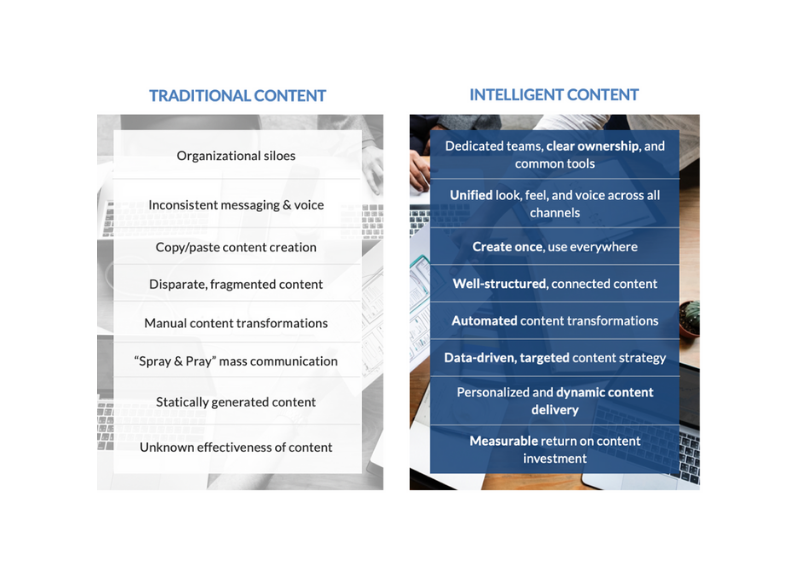
This is the fourth article in a series devoted to taking a closer look at the pillars for Intelligent Content activation: alignment, intelligence, technology, and process. This article will break down the technology pillar, exploring the systems needed to deliver content to an audience.
Implementing a content management system (CMS) or customer experience management (CEM) solution is key to enabling an intelligent content strategy. A CMS or CEM serves as the centralized store for content and provides an interface for creating, reviewing, approving, tagging, and publishing content.
Three main types of CMS/CEM solutions exist in the market:
Headless CMS
Web CMS
Experience platforms
Each type can vary in capabilities depending on the complexity and scalability needs of an organization. Additionally, a CMS or CEM solution may need to be augmented with a digital asset management (DAM) platform if your organization needs to distribute content externally or requires more robust asset management and search capabilities.
MarTech Architecture Design
Credera has developed a high-level MarTech reference architecture to provide an overview of the components needed to deliver relevant content to a consumer through their preferred channel. Within this reference architecture, CMS, CEM, and DAM solutions fit within the Content Management section highlighted in yellow below. Content must be designed, created, reviewed, approved, delivered, and stored before feeding into marketing automation tools, which then deliver relevant content to the customer through the appropriate channel.

Figure 1. MarTech Reference Architecture
Given the large number of CMS, CEM, and DAM offerings in the market, selecting the product(s) that best fit your company’s content strategy is challenging. Below is an overview of the major content management product types and things to consider when choosing between these tools.
Headess Content Management System
Headless CMS products provide content management capabilities without dictating the front end or presentation layers, but rather defining the information architecture and exposing the content via APIs to be leveraged across digital channels. This is a relatively new concept that empowers organizations to create customized and extensible applications that share a common content layer. Headless CMS offerings are the lowest-cost CMS/CEM option but require a higher level of technical maturity. Examples include GraphCMS, Prismic, Contentful, ButterCMS, Directus, and Contentstack.
A headless CMS platform is ideal for companies with the following objectives or criteria:
Minimal CMS needs: The existing system only needs to leverage the APIs to provide specific, dynamic content to one or many channels.
Seeking a lower cost option: Headless CMS solutions host content, digital assets, and media at a very low cost compared to a more robust CMS/CEM solution.
Desire to leverage existing infrastructure: Enhance existing platforms and infrastructure by adding strategic CMS capabilities rather than replacing user interface components with a CMS offering.
Providing multi-channel delivery: Manage content in one place and provide integrations to all digital channels.
The overall cost of ownership for a headless CMS is comparatively low. They follow a software-as-a-service (SaaS) model with the cost including web-based content creation, provider-hosted APIs and CDNs, maintenance provided by the vendor, and pricing dependent on the number of users and additional features. Internally, an organization will need employees to manage and administer content in the CMS tool in addition to IT involvement for making integration code changes.
Web Content Management Systems
Web content management systems (WCMS) are the most popular form of content management today. These platforms provide organizations with a full web stack and content management capabilities built in. In addition to the core content management capabilities, these platforms often include patterns and tools for integrating with other digital tools to augment the customer experience. Examples include Kentico, WordPress, Sitefinity, DNN, Umbraco, and Orchard.
A web CMS platform is ideal for companies with the following considerations:
Faster content release timelines: Less technical administration allows for decreased time-to-market in the release of new content.
Simplified content management: Web CMS platforms are easy to use and provide simplicity when making content management updates.
Site functionality: Add features to a site through the CMS without IT support.
Search: Provide customers the ability to search for site content.
The total cost of ownership for a web CMS falls between that of a headless CMS and experience platform. Licensing and infrastructure costs vary depending on if an on-premise, cloud, or hybrid architecture is selected, and support must be handled in-house, via a third-party service provider, or purchased through the platform provider. Internally, an organization will need employees to manage and administer the website.
Experience Platform
The experience platform is the “all-in-one” approach to content management platforms. In addition to the capabilities provided by headless and WCMS, the experience platform provides tools that target all aspects of digital marketing, customer engagement, customer insights and analytics, and omni-channel content delivery. Experience platforms are the highest-cost option but offer the most robust feature set and may enable a company to consolidate multiple systems into one. Examples include Adobe Experience Manager, IBM Watson Content Hub, Sitecore, Acquia, Oracle Content Management, and Episerver.
Experience platforms are ideal for companies with the following considerations:
Need for a single platform: Experience platforms provide a complete digital platform for website hosting, third-party integrations, and extensive MarTech capabilities in a single product that controls all aspects of a customer’s digital footprint.
Seeking comprehensive marketing and analytics: An experience platform provides tools and features to track, analyze, and personalize the customer experience based on a variety of factors, enabling users to obtain in-depth customer insights in a unified platform that informs and drives all marketing initiatives.
Robust administration and control: Organizations have complete control over security and governance using granular roles and permissions to cater to complex needs around content, governance, and publishing.
Seeking enterprise architecture: Best-in-class architecture supports scalability, monitoring, reporting, and future growth.
The cost structure for an experience platform is similar to that of a web CMS, however, the licensing costs are typically much higher and depend on whether an on-premise, cloud, or hybrid architecture is selected. Support and maintenance costs must be covered in-house, via a third-party service provider, or purchased through the platform provider. Internally, an organization will need employees to manage and administer the platform.
Comparison of All Platforms
Selecting a CMS/CEM platform is dependent on the organization’s content and technology needs. Companies that have an established site architecture and only need to surface content through APIs are the best fit for the low-cost headless CMS, while organizations seeking to quickly release content changes and manage the site through a simplified interface should consider a web CMS. Experience platforms carry the highest total cost of ownership but provide the most robust feature set, enabling organizations to control all aspects of a customer’s digital footprint. Below is a ranking of feature set capabilities across the three CMS/CEM product types:

Digital Asset Management
Digital asset management (DAM) solutions help companies manage, organize, share and distribute their digital assets from within one central library. They serve as the source of truth for digital assets and facilitate enhanced collaboration, organization, and distribution. All CMS systems contain a form of DAM functionality; however, a stand-alone DAM may be necessary depending on the organization’s content needs. DAM product offerings include MediaBeacon, Adobe Digital Asset Manager, Aprimo, Celum, and OpenText.
Companies should consider a separate DAM product if they require more robust functionality in the following areas:
External distribution: CMS platforms are adept at providing a place to store digital assets for use within the CMS (e.g., a content page), but when distributing those assets to outside channels, it does not work as well. A DAM solution provides tools to provide access for digital assets to external vendors and partners, disconnected systems, and versatile embed codes.
Asset creation: Beyond simply storing and accessing digital assets, a DAM can enable and support the creative process through features like file conversion and file sizing automation, draft/editing workflows, and version management.
Advanced search: While CMS platforms provide basic search capabilities, a DAM system provides advanced search capabilities that take greater advantage of metadata, keyword searches, content scraping (e.g., PDF text), and other attributes like popularity and usage.
Atomized assets: Re-usable content is key to driving efficiencies in the content creation process, and DAM solutions provide more robust feature sets for atomizing, finding, and creating new content from existing assets.
Take Your Next Step
Finding the CMS/CEM or DAM system that is right for your organization is critical to create a robust intelligent content strategy. Want to learn more about how to select the optimal content management solutions (i.e., CMS, CEM, DAM, etc.) tailored to your organization’s intelligent content strategy? Reach out to us at findoutmore@credera.com to speak with an intelligent content expert.
Contact Us
Ready to achieve your vision? We're here to help.
We'd love to start a conversation. Fill out the form and we'll connect you with the right person.
Searching for a new career?
View job openings



